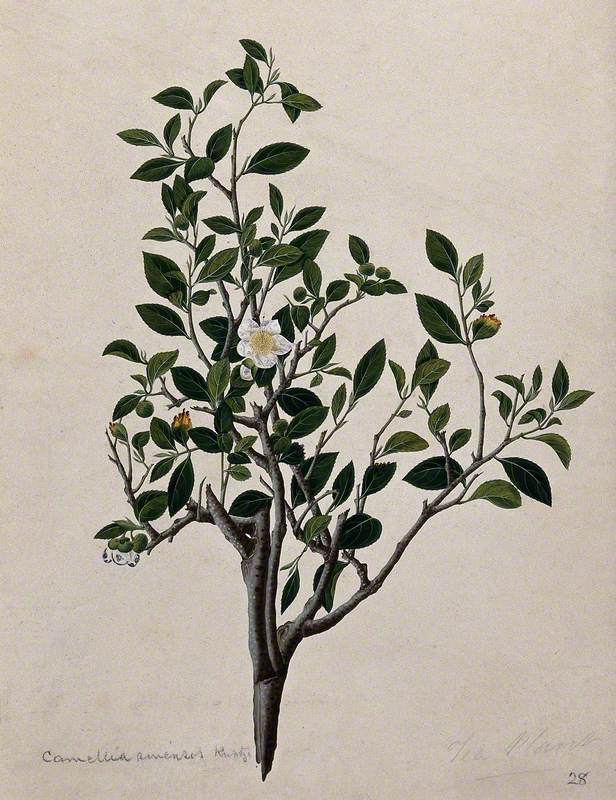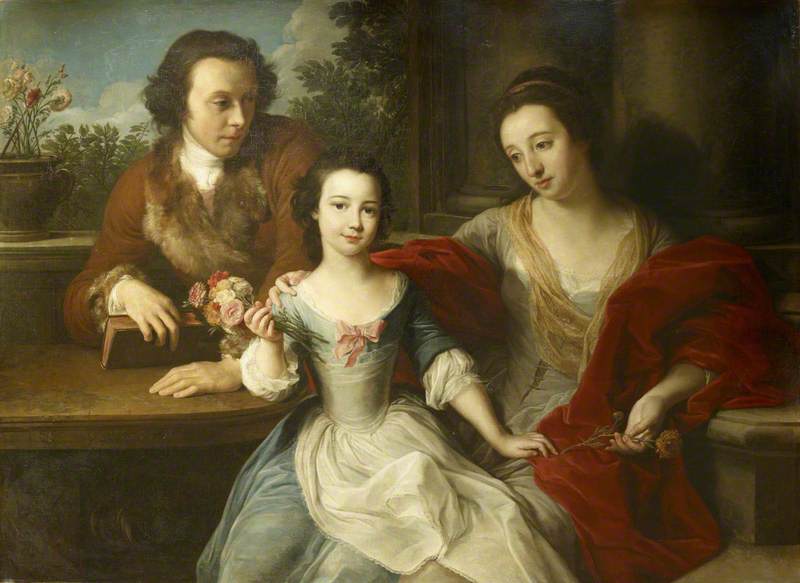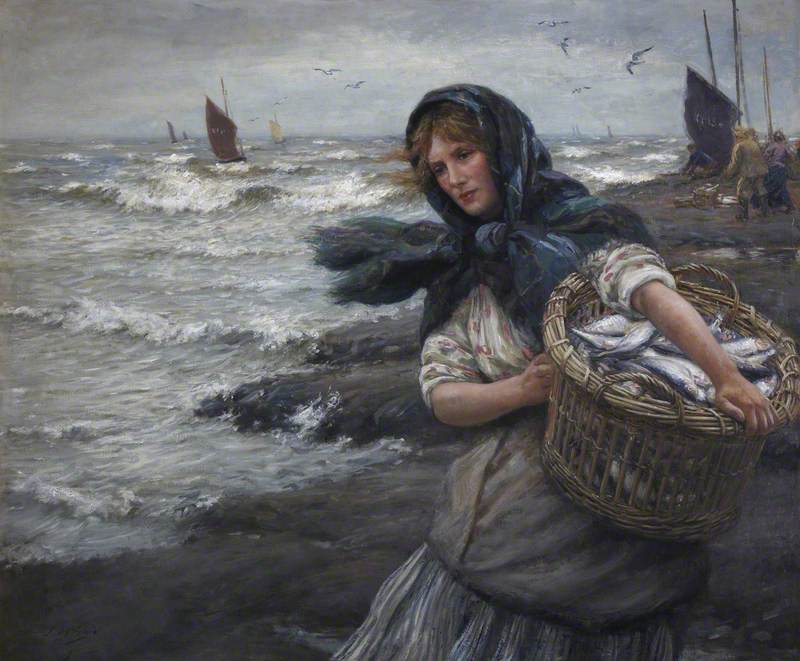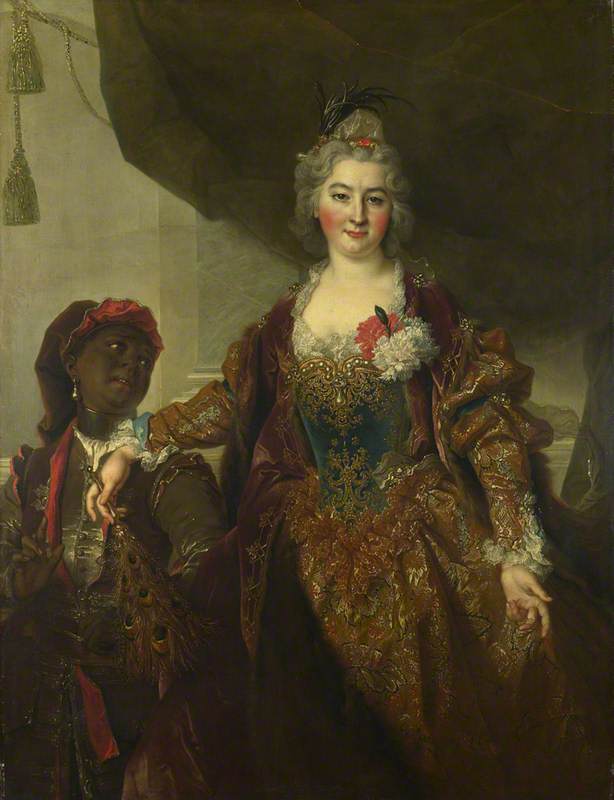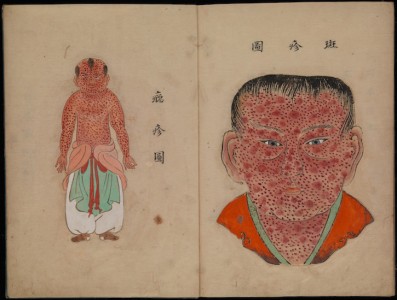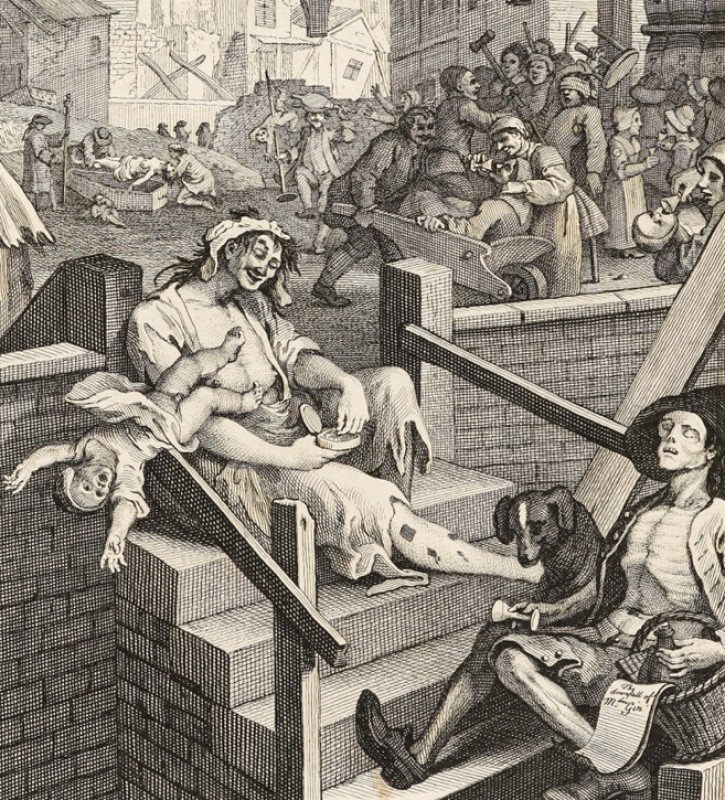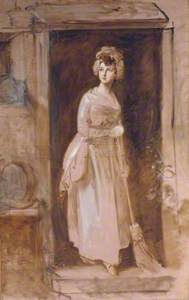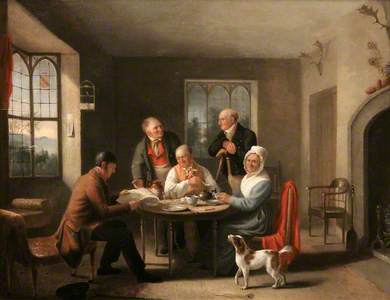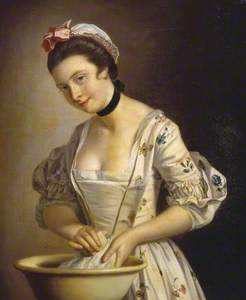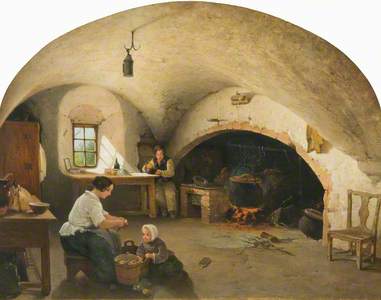The perfect servant was meant to be both visible and invisible: their polished appearance would assert their employers' status while their unending labour remained behind the scenes.
Domestic work has been a key role for centuries, encompassing a range of specialised jobs that support households and estates. Our modern conception of service was codified in the nineteenth century, with the Victorian insistence on clear class separation – including uniforms that suppressed any expression of individuality. The abolition of slavery in British territories from 1833 also pushed more people into service, although people of colour were often restricted to the least appealing and worst-paying jobs.
Domestic service was part of most households before the First World War, though the kinds of employment – and conditions – varied widely. Many domestic workers resided in their employers' households, their spare time closely surveilled, and their lives and status tied to the class of the family they served. Though closeness often developed in these relationships, especially through roles like childcare, servants appear most frequently in art as symbols rather than themselves. The variety and complexity of the ways they are portrayed reveal the cultural norms of the home, family, work, status and wealth.
A Young Lady trimming her Fingernails, attended by a Maidservant
probably 1670-5
Jacob Ochtervelt (1634–1682) 
Thanks to on-screen depictions like Downton Abbey and Upstairs Downstairs, it's easy to envision the starched caps and backstairs dramas of past centuries. But these glamourised, nostalgic depictions often gloss over the deeply ingrained social and class hierarchies people faced. And they tell only a fraction of the story of domestic workers, who made up four per cent of the UK population at the turn of the twentieth century.
Below are a few of the ways servants and their work have been depicted through the centuries; at turns subjugated, idealised, symbolic, comedic, familial and functional – and, very occasionally, as themselves.
Class hierarchies and status symbols
Servants were included in artwork across the centuries to reinforce the status of the people they worked for. This c.1585 portrait of a family saying grace shows both their religious devotion and their worldly wealth, as a servant enters with another dish for their meal.
A Family Saying Grace before a Meal
c.1585
Anthuenis Claeissens (c.1536–1613) 
A 1690/1700 painting by Johannes Voorhout shows a lady with a servant washing her feet, quite literally placed beneath her and tasked with the unappealing and dirty work.
A Lady in an Interior with a Servant Washing Her Foot
c.1690/1700
Johannes Voorhout (1647–1717) 
The social hierarchy was also mirrored in the hierarchy of the servants' hall. In larger households, the roles and precedence of maids, footmen, housekeepers and butlers were strictly reinforced in rules that defined their behaviour, privileges and clothing. Access to these jobs was delineated along both gendered and racial lines; the housekeeper, a woman, would oversee the female servants, while the male butler had charge of the menservants. Frederick William Elwell's 1911 painting of The Housekeeper's Room shows the discipline and subservience that was expected.
However, given the closeness of domestic work, servants and employers were not always as divided as the arbitrary distinctions of class would presume. A copy after Frans van Mieris shows a maid just next to an unfinished portrait of a lady, both gazing directly at the viewer: they could almost be sisters. It's hard to tell whether the canvas is insisting upon or eliding the divisions between the women – and instead emphasising their common humanity.
An idealised view
People who worked in service typically could not afford to pay for their own portraits, and had therefore to accept being depicted as background players or convenient models, at the patron or artist's whim. As such, many servants provided convenient models for artists to romanticise in depictions of domestic quietude. In Thomas Gainsborough's unfinished 1780s painting, the distant gaze of a housemaid paused in her sweeping suggests she may be pondering a life of less drudgery.
Artists and makers of popular culture projected stereotypes and moral judgments onto domestic workers: qualities like humility, modesty and discretion were deemed essential, while perceived 'loose' morals could cost someone their job. As the title of George Dunlop Leslie's painting suggests, 'In silence I stood your unkindness to hear...', servants often had no recourse for poor treatment or accusations of bad behaviour – being fired from a position without a reference made it nearly impossible to find another.
Mollie, 'In silence I stood your unkindness to hear...'
1882
George Dunlop Leslie (1835–1921) 
Leslie specialised in romantic portrayals of women servants and 'the sunny side of English domestic life', like this docile depiction of a gardener's daughter carrying a flower-filled basket from the late nineteenth century. The popularity of these kinds of images shows the appetite for ideal, rather than real, visions of how society and domestic work functioned.
Part of the family
Domestic workers were expected to be loyal to their employers – in return, good employers were expected to provide housing, medical care and support in retirement. Though without regulation, these benefits were entirely dependent on an employer's beneficence. Still, strong familial sentiment could grow on both sides over decades of close working relationships under the same roof.
A series of portraits of servants commissioned by the Yorke family at Erdigg illustrate this family feeling; it was begun in the 1790s, with short accompanying texts describing each sitter and their role. The 1793 portrait of Mrs Jane Ebrell at age 87 describes her as a former housemaid and spider-brusher.
Mrs Jane Ebrell (b.1706), Former Housemaid and 'Spider-Brusher', Aged 87
1793
John Walters (1721–1797) 
At large estates, hosting a servants' ball was an annual event in the nineteenth and early twentieth centuries that allowed a temporary relaxing of the strict protocols between upstairs and downstairs. The New Year's ball at Lyme Park was painted by the 13-year-old daughter of the house.
The Servants' New Year's Eve Ball in the Entrance Hall at Lyme Park
c.1906
Phyllis Elinor Legh (1895–1986) 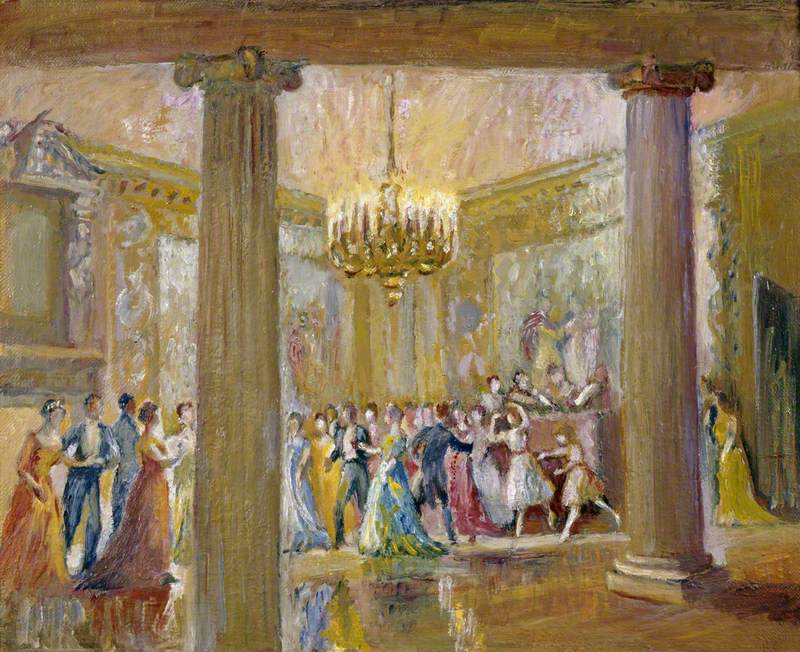
For many workers, assured accommodation and meals were part of the appeal of domestic work. Their closest relationships would be formed with the fellow servants who they lived, worked and ate with. Paintings of staff in the servants' hall or kitchen, often their only gathering place, show the familiarity of these relationships.
Stereotyping servants
Several stereotypes became associated with domestic workers based on their intimate position within the household – especially the idea of 'servants' gossip', which was frequently castigated in texts and visual art in attempts to prevent family secrets from spilling. A painting of The Gossips by Pierre Beyle shows three women exchanging stories while cleaning together, an easy exchange of information that could strike fear in employers' hearts.
Because of their vulnerable position, many servants faced unwanted advances from employers and others with social power – especially women, who comprised the vast majority of domestic workers by 1901. As historian Lucy Delap points out, women servants were seen as sexually accessible due to their lack of privacy and status, and looked down upon as dirty due to the nature of their work – both of which contributed to their eroticisation in popular culture.
David Teniers II's c.1650 genre painting of an old man approaching a kitchen maid was intended to be comical, allowing wealthy collectors to look down on the supposedly lewd manners of the working classes.
An Old Peasant caresses a Kitchen Maid in a Stable
about 1650
David Teniers II (1610–1690) 
Nicholas Maes' lady of the house eagerly eavesdropping on a below-stairs dalliance also reinforces the stereotypes of ribald domestic behaviour. The composition reiterates moral hierarchies, suggesting lower morals below stairs and upright behaviour above.
The well-dressed lady's maid of Henry Robert Morland's c.1765–1782 painting gazes coyly at the viewer while soaping linen – not a typically seductive task. Her fine clothing suggests her higher status in service as a lady's maid, rather than a general servant or household 'drudge' – as such, she might receive slightly more respectful treatment based on her smidgen of status, or possibly aspire to higher social goals.
Stereotypes were not confined to women servants – because of their privileged access to the wine cellar, butlers were sometimes assumed to be immoderate drinkers and the butt of jokes in prints and cartoons. This somewhat more temperate painting may simply illustrate a reward for a hard day's work.
The Butler Takes a Glass of Port (All Things Come to the Man That Waits)
1890–1899
Frederick William Elwell (1870–1958) 
Realistic takes
Some rare artworks depict the reality of domestic work – like Jean-Baptiste Chardin's sympathetic depiction of a worn-out scullery maid scrubbing a pan.
The dirt floor and cracking wall plaster also show a more down-to-earth view of the kitchen of Barra Castle in 1854, with a woman peeling potatoes as a child helps (or hinders) at her feet.
The Kitchen of Barra Castle, Aberdeenshire
1854
James Cassie (1819–1879) 
Popular culture tends to highlight the fleet of workers that ran the wealthiest aristocratic estates, but only one-fifth of households in 1911 had more than three servants; for most middle-class households, a 'maid-of-all-work' would carry out all of the domestic tasks. One of these, Florence Head, was painted by her employer – and seemingly not best pleased about it.
In addition to realistic depictions of domestic workers and their challenging jobs, sensitive and dignified portraits can be found, such as the one of Duffadar Valayat Shah, who was orderly to a Viceroy of India.
The Viceroy's Orderly (Duffadar Valayat Shah)
1915
William Nicholson (1872–1949) 
Similarly, George Percy Jacomb-Hood's elegiac portrait of The Butler, though unnamed, conveys the grey-haired man's steadfastness and attention to duty over many years.
Invisible and unrecorded
Millions of homes, grand and not, were kept spick and span by domestic workers whose lives went largely unrecognised and unrecorded. In this nineteenth-century painting, light filters gently into a Great Hall, which contains marble busts and a chandelier that need dusting, dogs that require feeding and cleaning up after, and a fireplace that demands sweeping and laying. Meanwhile, the master of the house is pictured reading in a chair. What's absent, of course, are the workers who make the quiet scene possible.
The Interior of a Large Country House (Great Hall, Mount Edgcumbe)
John Scarlett Davis (1804–1845) 
Domestic service gradually declined through the twentieth century with the rise of industrial jobs, wartime roles that opened up new careers for women, and more modern technologies that made household cleaning easier. As people in service moved to other careers, many jobs were filled by migrant workers – first from Ireland and Wales, and later Commonwealth and former Commonwealth countries – but these workers were and are more vulnerable, with less recourse to other options if they find themselves in an exploitative situation.
Service remains integral to how our economy and society function, with domestic work simply reconfigured in each era. We have fewer live-in workers now, but there is constant demand for babysitters, au pairs, housekeepers, cleaners and any number of hospitality jobs.
Saturday
(an interior view of Garstin's home)
Norman Garstin (1847–1926) 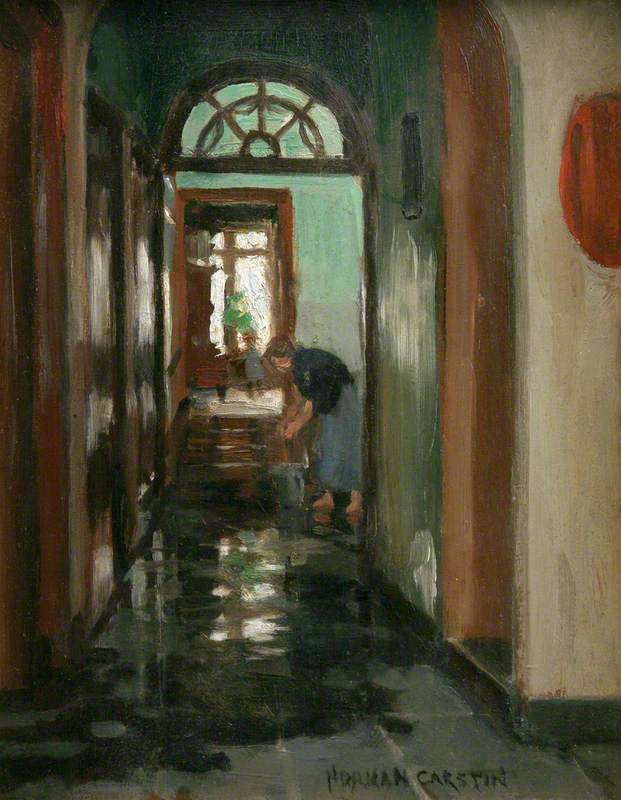
In Mollie Panter-Downes' 1931 novel My Husband Simon, the upper-middle-class narrator suddenly reflects on the structure of her domestic life and her live-in help. 'I thought of the queer, secretive existence that servants lead, huddled together in basements like a strange breed of burrowing animals, baffling and incomprehensible. There, two yards away from me, is another human being...
"Katie."
"Yes, m'm?"
"Do you ever feel that you want to scream?"'
Anne Wallentine, writer, editor and art historian
Further reading
Margaret Powell, Below Stairs, St Martin's Press, 2012
Lucy Delap, Knowing Their Place: Domestic Service in Twentieth-Century Britain, Oxford, 2011
Lucy Lethbridge, Servants: A Downstairs History of Britain from the Nineteenth Century to Modern Times, Norton, 2013
Jean Rennie, Every Other Sunday, St Martin's Press, 1981

















